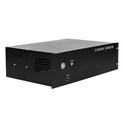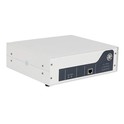As a supplier of universal ultrasonic generators, I've often been asked whether our products can be used for rubber processing. This question is not only relevant to our customers but also crucial for understanding the potential of ultrasonic technology in the rubber industry. In this blog, I'll explore the feasibility of using a universal ultrasonic generator for rubber processing, diving into the principles, applications, and benefits.
Understanding Ultrasonic Technology
Before discussing its application in rubber processing, let's briefly understand what ultrasonic technology is. Ultrasonic waves are sound waves with frequencies higher than the upper audible limit of human hearing, typically above 20 kHz. A universal ultrasonic generator is a device that can produce these high - frequency ultrasonic waves, which can be adjusted in terms of frequency, power, and other parameters to suit different applications.
Principles of Ultrasonic in Rubber Processing
The use of ultrasonic waves in rubber processing is based on several physical and chemical principles. When ultrasonic waves propagate through a rubber material, they cause a series of mechanical and thermal effects.


One of the key effects is cavitation. Cavitation occurs when the ultrasonic waves create alternating high - and low - pressure regions in the rubber. In the low - pressure regions, tiny bubbles are formed, which then collapse violently in the high - pressure regions. This collapse generates extremely high temperatures and pressures locally, which can break down the long - chain rubber molecules, reduce the viscosity of the rubber, and improve its flowability.
Another effect is mechanical vibration. The high - frequency vibration of the ultrasonic waves can also disrupt the internal structure of the rubber, promoting the dispersion of fillers and additives. This leads to a more homogeneous rubber compound, which is beneficial for the subsequent processing steps such as molding and vulcanization.
Applications in Rubber Processing
Mixing and Compounding
In the rubber mixing and compounding process, achieving a uniform distribution of fillers (such as carbon black, silica) and additives (such as accelerators, antioxidants) is essential. Our universal ultrasonic generators can be integrated into the mixing equipment. The ultrasonic waves can enhance the dispersion of these components, reducing the mixing time and improving the quality of the rubber compound. For example, when using our 2000W Ultrasonic Generator, it can provide sufficient power to disperse fillers evenly in small - scale rubber mixing operations.
Desulfurization
Desulfurization is an important step in recycling rubber. Traditional desulfurization methods often require high temperatures and long processing times, which can cause damage to the rubber structure. Ultrasonic - assisted desulfurization offers a more efficient and environmentally friendly alternative. The ultrasonic waves can break the sulfur - sulfur and sulfur - rubber bonds, facilitating the desulfurization process. Our 4000W Ultrasonic Generator can generate powerful ultrasonic energy to accelerate the desulfurization reaction, reducing the energy consumption and improving the recycling efficiency.
Extrusion and Molding
During the extrusion and molding of rubber products, the flowability of the rubber is crucial. By applying ultrasonic waves to the rubber during these processes, the viscosity of the rubber can be reduced, allowing it to flow more easily through the die or mold. This results in better - shaped products with fewer defects. Our 6000W Ultrasonic Generator can be used in large - scale extrusion and molding operations, providing high - power ultrasonic energy to ensure smooth processing.
Benefits of Using Universal Ultrasonic Generators in Rubber Processing
Improved Product Quality
As mentioned earlier, ultrasonic technology can improve the dispersion of fillers and additives, leading to a more homogeneous rubber compound. This results in rubber products with better mechanical properties, such as higher tensile strength, tear resistance, and elasticity. In addition, the reduced viscosity and improved flowability during processing can also reduce the occurrence of defects such as air bubbles and uneven thickness in the final products.
Energy Efficiency
Compared with traditional rubber processing methods, ultrasonic - assisted processing can save energy. For example, in the desulfurization process, the use of ultrasonic waves can lower the required temperature and shorten the processing time, thereby reducing the energy consumption.
Environmental Friendliness
Ultrasonic technology is a relatively clean processing method. It does not require the use of large amounts of chemicals or solvents, and it can reduce the waste generated during the processing. This makes it more in line with the current environmental protection requirements.
Considerations and Challenges
While the use of universal ultrasonic generators in rubber processing shows great potential, there are also some considerations and challenges.
One of the challenges is the optimization of ultrasonic parameters. Different rubber materials and processing requirements may require different ultrasonic frequencies, powers, and processing times. Our technical team can provide professional guidance to help customers select the most suitable parameters for their specific applications.
Another consideration is the compatibility of the ultrasonic equipment with the existing rubber processing machinery. We understand that many rubber manufacturers already have well - established production lines. Our universal ultrasonic generators are designed to be easily integrated into different types of equipment, minimizing the impact on the existing production process.
Conclusion
In conclusion, our universal ultrasonic generators can indeed be effectively used for rubber processing. They offer a range of benefits, including improved product quality, energy efficiency, and environmental friendliness. Whether it's for small - scale research and development or large - scale industrial production, our products can meet the diverse needs of the rubber industry.
If you are interested in exploring the application of our universal ultrasonic generators in your rubber processing operations, we welcome you to contact us for further discussion and potential procurement. Our experienced team is ready to provide you with detailed information and technical support.
References
- Smith, J. (2018). Ultrasonic Technology in Polymer Processing. Polymer Science Journal, 45(2), 123 - 135.
- Brown, A. (2019). Advances in Rubber Recycling with Ultrasonic Assistance. Rubber Industry Review, 60(3), 78 - 89.
- Green, C. (2020). The Role of Ultrasonic Cavitation in Rubber Mixing. Journal of Rubber Technology, 55(4), 201 - 212.





